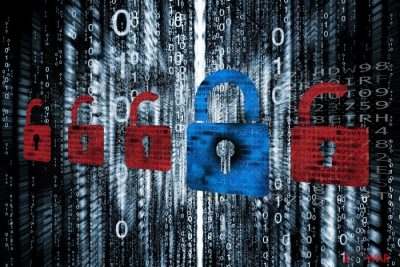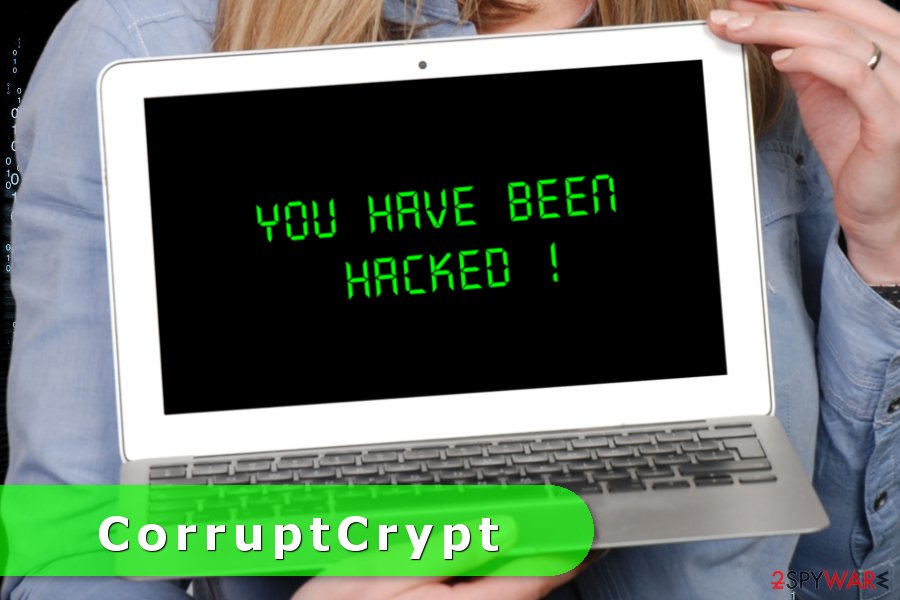CorruptCrypt ransomware / virus (Free Instructions) - Decryption Steps Included
CorruptCrypt virus Removal Guide
What is CorruptCrypt ransomware virus?
CorruptCrypt uses strong encryption algorithm to make files inaccessible

CorruptCrypt is a file-encrypting virus that uses AES cryptography to corrupt files on the affected computer. During data encryption, it appends either .corrupt or .acryhjccbb@protonmail.com file extensions to make data unable to open and use.
The malicious program has been noticed spreading in Crypt.exe file which often is camouflaged as an email attachment, software update or download. As soon as CorruptCrypt ransomware is executed on the system, it makes several system changes and starts data encryption procedure.
The CorruptCrypt virus is still under investigation; however, it might:
- modify or create new Windows Registry entries to boot with system startup;
- inject malicious code to legit processes to strengthen its presence and perform data encryption;
- open backdoor to other malware;
- make the system vulnerable;
- pose privacy-related issues.
There’s no doubt that the most import task of the CorruptCrypt is to encode personal files stored on the targeted computer. After the infiltration, ransomware[1] starts scanning the system and looking for the most popular files for encryption, including MS Word, OpenOffice, PDFs, texts, pictures, video, archives, databases, and many more.
Following data encryption, malware drops a ransom note where crooks should provide data recovery instructions and reveal the size of the ransom they want to get for the decryption software. However, researchers haven’t found the sample of a ransom note yet.
All ransomware-type cyber threats ask for a different amount of money in exchange for a decryption software. However, instead of obtaining unknown decryptor, victims are advised to perform the CorruptCrypt removal. Crooks are not reliable people and might disappear once they receive the desired payment.
In order to remove CorruptCrypt from the system entirely, you have to obtain a reputable malware removal software, such as FortectIntego. Once you install a program, update it and then run a full system scan. When security software eliminates the crypto-malware, you can restore your files from backups or try alternative methods presented at the end of the article.

Crypto-malware might find the way to the computer using several methods
One of the most important prevention tips – learning how ransomware viruses spread. CorruptCrypt malware might be spread using traditional methods, such as:
- malicious spam emails and their attachments;
- malware-laden ads that might be displayed on both – legit and compromised websites;
- bogus software downloads;
- fake pop-ups that inform about available updates;
- weak RDP connections;[2]
- security vulnerabilities and outdated software.
As you can see, there are numerous ways how malware might sneak into your device. Thus, you should stay vigilant and avoid clicking or downloading suspicious content. Security experts from Les Virus[3] warn that the biggest dangers are hiding in the inbox. Thus, users should be careful with received emails and open attachments only if they are 100% sure about its safety.
However, security experts also recommend obtaining reliable security software and creating backups. Backups are crucial after ransomware attack and prevent from paying the ransom.
Deletion of the CorruptCrypt ransomware virus
The only safe way to remove CorruptCrypt from the system is to use professional malware removal tools. The virus consists of dozens of different files and other components that must be eliminated. This task is nearly impossible to complete manually.
For CorruptCrypt removal we recommend using FortectIntego or Malwarebytes. However, in some cases, file-encrypting viruses prevent from installing security software. Thus you should reboot the device in Safe Mode with Networking first. This method helps to disable the virus and terminate it with anti-malware tool.
Getting rid of CorruptCrypt virus. Follow these steps
Manual removal using Safe Mode
Follow these steps to enable security software and remove the virus:
Important! →
Manual removal guide might be too complicated for regular computer users. It requires advanced IT knowledge to be performed correctly (if vital system files are removed or damaged, it might result in full Windows compromise), and it also might take hours to complete. Therefore, we highly advise using the automatic method provided above instead.
Step 1. Access Safe Mode with Networking
Manual malware removal should be best performed in the Safe Mode environment.
Windows 7 / Vista / XP
- Click Start > Shutdown > Restart > OK.
- When your computer becomes active, start pressing F8 button (if that does not work, try F2, F12, Del, etc. – it all depends on your motherboard model) multiple times until you see the Advanced Boot Options window.
- Select Safe Mode with Networking from the list.

Windows 10 / Windows 8
- Right-click on Start button and select Settings.

- Scroll down to pick Update & Security.

- On the left side of the window, pick Recovery.
- Now scroll down to find Advanced Startup section.
- Click Restart now.

- Select Troubleshoot.

- Go to Advanced options.

- Select Startup Settings.

- Press Restart.
- Now press 5 or click 5) Enable Safe Mode with Networking.

Step 2. Shut down suspicious processes
Windows Task Manager is a useful tool that shows all the processes running in the background. If malware is running a process, you need to shut it down:
- Press Ctrl + Shift + Esc on your keyboard to open Windows Task Manager.
- Click on More details.

- Scroll down to Background processes section, and look for anything suspicious.
- Right-click and select Open file location.

- Go back to the process, right-click and pick End Task.

- Delete the contents of the malicious folder.
Step 3. Check program Startup
- Press Ctrl + Shift + Esc on your keyboard to open Windows Task Manager.
- Go to Startup tab.
- Right-click on the suspicious program and pick Disable.

Step 4. Delete virus files
Malware-related files can be found in various places within your computer. Here are instructions that could help you find them:
- Type in Disk Cleanup in Windows search and press Enter.

- Select the drive you want to clean (C: is your main drive by default and is likely to be the one that has malicious files in).
- Scroll through the Files to delete list and select the following:
Temporary Internet Files
Downloads
Recycle Bin
Temporary files - Pick Clean up system files.

- You can also look for other malicious files hidden in the following folders (type these entries in Windows Search and press Enter):
%AppData%
%LocalAppData%
%ProgramData%
%WinDir%
After you are finished, reboot the PC in normal mode.
Remove CorruptCrypt using System Restore
These instructions can help to disable the virus in order to run automatic removal:
-
Step 1: Reboot your computer to Safe Mode with Command Prompt
Windows 7 / Vista / XP- Click Start → Shutdown → Restart → OK.
- When your computer becomes active, start pressing F8 multiple times until you see the Advanced Boot Options window.
-
Select Command Prompt from the list

Windows 10 / Windows 8- Press the Power button at the Windows login screen. Now press and hold Shift, which is on your keyboard, and click Restart..
- Now select Troubleshoot → Advanced options → Startup Settings and finally press Restart.
-
Once your computer becomes active, select Enable Safe Mode with Command Prompt in Startup Settings window.

-
Step 2: Restore your system files and settings
-
Once the Command Prompt window shows up, enter cd restore and click Enter.

-
Now type rstrui.exe and press Enter again..

-
When a new window shows up, click Next and select your restore point that is prior the infiltration of CorruptCrypt. After doing that, click Next.


-
Now click Yes to start system restore.

-
Once the Command Prompt window shows up, enter cd restore and click Enter.
Bonus: Recover your data
Guide which is presented above is supposed to help you remove CorruptCrypt from your computer. To recover your encrypted files, we recommend using a detailed guide prepared by 2-spyware.com security experts.If your files are encrypted by CorruptCrypt, you can use several methods to restore them:
Data Recovery Pro might help to restore encrypted files
This tool is designed to restore data after system wreckage. However, it might help after ransomware attack as well.
- Download Data Recovery Pro;
- Follow the steps of Data Recovery Setup and install the program on your computer;
- Launch it and scan your computer for files encrypted by CorruptCrypt ransomware;
- Restore them.
Try Windows Previous Versions feature
If System Restore has been enabled before ransomware attack, you can travel back in computer's time and restore individual files by following these steps:
- Find an encrypted file you need to restore and right-click on it;
- Select “Properties” and go to “Previous versions” tab;
- Here, check each of available copies of the file in “Folder versions”. You should select the version you want to recover and click “Restore”.
Use ShadowExplorer
If CorruptCrypt did not delete Shadow Volume Copies of the targeted files, you can restore files using this tool:
- Download Shadow Explorer (http://shadowexplorer.com/);
- Follow a Shadow Explorer Setup Wizard and install this application on your computer;
- Launch the program and go through the drop down menu on the top left corner to select the disk of your encrypted data. Check what folders are there;
- Right-click on the folder you want to restore and select “Export”. You can also select where you want it to be stored.
CorruptCrypt decryptor is not available yet.
Finally, you should always think about the protection of crypto-ransomwares. In order to protect your computer from CorruptCrypt and other ransomwares, use a reputable anti-spyware, such as FortectIntego, SpyHunter 5Combo Cleaner or Malwarebytes
How to prevent from getting ransomware
Stream videos without limitations, no matter where you are
There are multiple parties that could find out almost anything about you by checking your online activity. While this is highly unlikely, advertisers and tech companies are constantly tracking you online. The first step to privacy should be a secure browser that focuses on tracker reduction to a minimum.
Even if you employ a secure browser, you will not be able to access websites that are restricted due to local government laws or other reasons. In other words, you may not be able to stream Disney+ or US-based Netflix in some countries. To bypass these restrictions, you can employ a powerful Private Internet Access VPN, which provides dedicated servers for torrenting and streaming, not slowing you down in the process.
Data backups are important – recover your lost files
Ransomware is one of the biggest threats to personal data. Once it is executed on a machine, it launches a sophisticated encryption algorithm that locks all your files, although it does not destroy them. The most common misconception is that anti-malware software can return files to their previous states. This is not true, however, and data remains locked after the malicious payload is deleted.
While regular data backups are the only secure method to recover your files after a ransomware attack, tools such as Data Recovery Pro can also be effective and restore at least some of your lost data.
- ^ Ransomware. Tech Terms. Tech Terms computer dictionary.
- ^ Jeff Goldman. Flood of Attacks Spread Ransomware via Remote Desktop Protocol. eSecurity Planet. Internet Security for IT Professionals.
- ^ Les Virus. Les Virus. Cyber security news.





















